Montreal << `mon ` tree AWL >> is the second largest city in Canada, after Toronto, and the largest city in the province of Quebec. Montreal is also one of the world’s largest French-speaking cities. More than half of Montreal’s people speak French as their first language. In addition, Montreal is a major center of Canadian education, culture, business, and industry.
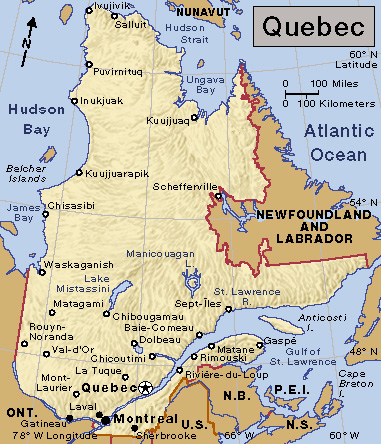
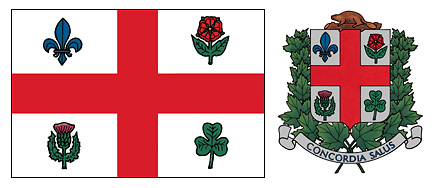
The city of Montreal lies on an island and is built around a mountain. The Island of Montreal sits in the St. Lawrence River, near where the St. Lawrence and Ottawa rivers meet in southern Quebec. A tree-covered peak, Mount Royal, rises 763 feet (233 meters) in the island’s center. Mount Royal gave the city its name.

The name Montreal can refer to the city itself or the broader metropolitan area. The broader area, known as Greater Montreal, includes the city of Montreal and surrounding suburbs.
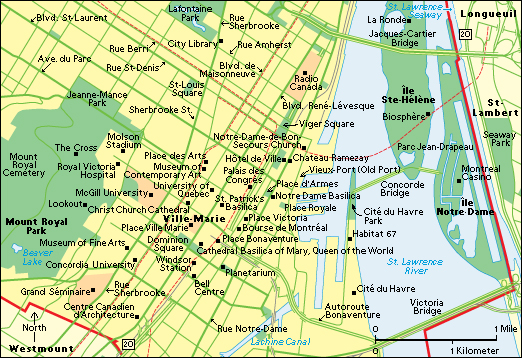
Montreal is a modern metropolis with office towers, universities, a casino, luxury shopping areas, a subway, deluxe hotels, professional sports teams, major museums, and a glittering nightlife. Residents take pride in making the best of the sometimes fierce winter weather. Montreal’s National Hockey League team, the Canadiens, has had one of the most successful histories of any team in professional sports. The city also is known for the fashion sense of les montrealaises (the women of Montreal).
In 1535, the French explorer Jacques Cartier became the first European to reach the site that is now Montreal. Cartier climbed the highest peak on the site and named it Mont Réal (Royal Mountain, or Mount Royal). At the time, a First Nations (American Indian) village called Hochelaga occupied the future city site. Hochelaga disappeared some time in the 1500’s. The first permanent European settlement on the site was established in 1642. That year, Paul de Chomedey, Sieur (Lord) de Maisonneuve, a former French Army officer, brought a small group of Roman Catholic missionaries and settlers to the island from France. The settlement was first called Ville-Marie (City of Mary) in honor of the Virgin Mary, the mother of Jesus Christ. But by the early 1700’s, the town had become identified with the mountain and was called Montreal.
Today, Montreal faces challenges related to changes in its ethnic population. Many French-speaking people have moved to suburbs off Montreal Island, and many immigrants have moved into the city. As a result, there is some social and political tension between people who welcome Montreal’s growing ethnic diversity and people who wish to maintain the city’s French character.
Tension also exists between Montreal and the rest of Quebec. Montreal has many immigrants, English speakers with ties to other Canadian provinces, and French Quebecers who also speak English. But the rest of Quebec remains deeply French in identity.
In addition, Montreal faces problems common to other large cities. These problems include poverty, declining quality and availability of public services, drug abuse, criminal gangs, and pollution. However, Montreal has a reputation for being a safe, low-crime city.
The city
The city of Montreal covers the Island of Montreal and smaller nearby islands. The Island of Montreal is triangular, measuring about 32 miles (51 kilometers) long and 10 miles (16 kilometers) wide at its widest point. It covers 191 square miles (495 square kilometers). Greater Montreal includes all of Montreal Island, Jesus Island to the north, several smaller islands, and parts of the Quebec mainland. The official Montreal metropolitan area covers 1,803 square miles (4,670 square kilometers).
The Montreal downtown area, called le centre-ville in French, lies between the St. Lawrence River and Mount Royal. A huge park covers the top of Mount Royal. The city’s historic district, next to downtown and bordering the river, is called Vieux-Montréal (Old Montreal). Residential areas stretch away from downtown to the geographic north, south, and west.
Montrealers have an unusual way of describing directions in Montreal. For example, Boulevard St.-Laurent (also known as The Main), one of Montreal’s chief streets, is described by residents as running from south to north, away from the river. Geographically, however, this street runs more southeast to northwest. The lively, ethnic St.-Laurent divides east and west street addresses in Montreal.
Boulevard St.-Laurent was long considered the dividing line between the heavily francophone (French-speaking) east side and the more anglophone (English-speaking) west side. Geographically, the east and west sides are more nearly the northern and southern parts of the city. During the 1980’s and 1990’s, Montreal saw increases in immigration, private-car travel, and bilingualism (ability to speak two languages). Today, as a result, English, French, and other languages can be heard anywhere in Montreal.
The St. Lawrence River and the Lachine Canal have historically been important commercial and industrial corridors. The canal, which crosses southern Montreal Island, served as a detour around the river’s Lachine Rapids. Since about 1940, however, changes in technology and transportation have significantly reduced heavy industrial activity along the river and the canal. The river remains an important route for cargo vessels, but the canal is no longer in use for commercial shipping. Homes, stores, and recreational areas are replacing old industrial structures along the waterways.
Downtown Montreal
has several streets with special characteristics. The wide Boulevard René-Lévesque (formerly Dorchester Boulevard) crosses the heart of downtown Montreal and is known for its skyscrapers. The city’s best-known skyscraper is an office center commonly called Place Ville Marie. The building rises 615 feet (187 meters) and is laid out in the shape of a cross. The height and shape of the building, as well as its rotating rooftop searchlight, have made it a city landmark.
Rue Ste.-Catherine, a block away from Boulevard René-Lévesque, is noted for its shops, restaurants, and theaters. The fashionable Rue Sherbrooke, two blocks away from Rue Ste.-Catherine, attracts many visitors to its luxurious antique shops and art galleries. Rue is the French word for street.
The city’s harsh winter climate has led to the growth of the Cité Souterrain (Underground City). The Underground City is a network of passages beneath the downtown streets. Shops and restaurants line the passages, which link many public buildings and also provide access to several stations of the Métro, Montreal’s subway.

Old Montreal
borders the St. Lawrence River between Rue Berri and Rue McGill. Many of the old stone buildings of Old Montreal stand side by side with tall, modern structures. Charming restaurants, historic houses, and boutiques (small stores) line the area’s narrow streets. Several of these streets are paved with cobblestones. Because Old Montreal has a European feel, producers often film movies and TV shows there. Old Montreal opens onto the Vieux-Port (Old Port), now a waterfront area of museums and other attractions.
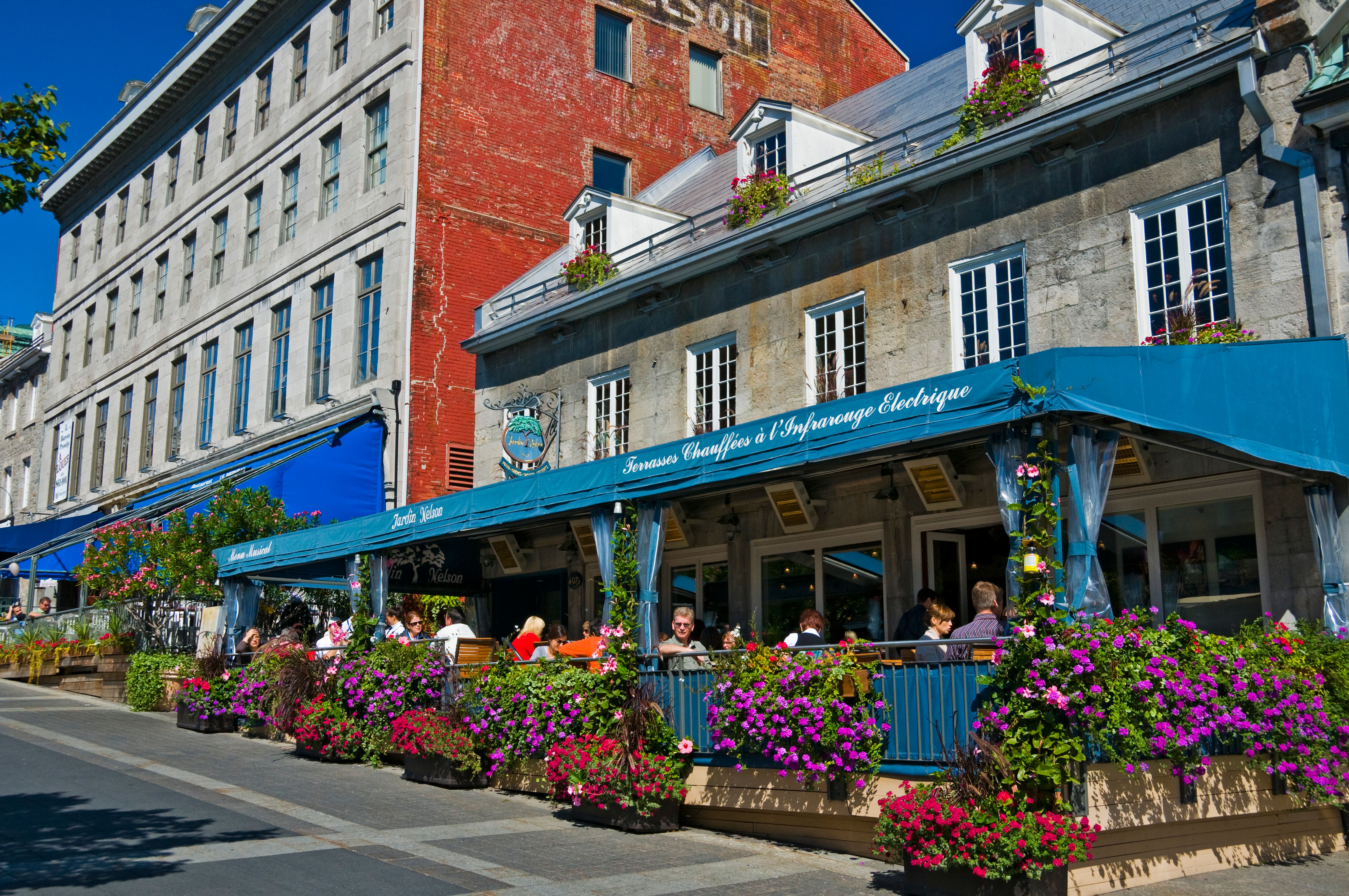
Old Montreal has many reminders of Montreal’s rich history. The city’s oldest church, Notre-Dame-de-Bon-Secours, stands on Rue St.-Paul in Old Montreal. This Roman Catholic stone chapel was built in 1771 on the foundations of an earlier church. The St. Sulpice Seminary is on Rue Notre-Dame. Also known as the Vieux-Séminaire (Old Seminary), it is the oldest building in Montreal. It was built in the 1680’s and since 1685 has served as a residence for priests and other religious functions.
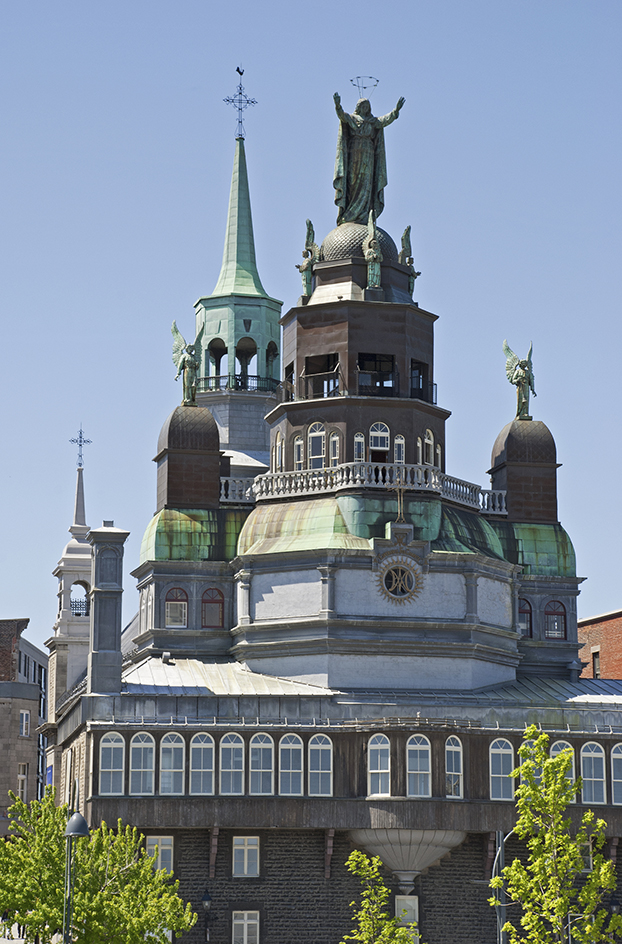
Two historic squares are near the seminary. Across Rue Notre-Dame is Place d’Armes (Parade Ground). The first clash between Ville-Marie’s founders and the Iroquois Indians took place there in 1644. The Maisonneuve Monument in the square honors the city’s founder. Also near the seminary, on Rue St.-Paul, is Place Royale (Royal Square). This square was the site of the original Ville-Marie settlement of 1642.
Bank and insurance company offices border Place d’Armes. The area also has several government buildings, including courthouses and Montreal’s Hôtel de Ville (City Hall). The city’s large, modern Palais des Congrès de Montréal (Montreal Convention Centre) stands where Old Montreal merges into downtown.
Metropolitan area.
Greater Montreal is Canada’s second largest urban area. Only the Toronto metropolitan area is larger. Montreal’s largest suburbs by population are Longueuil, on the south (geographic east) shore of the St. Lawrence, and Laval, on Jesus Island.
People
Montrealers call themselves francophone, anglophone, or allophone, depending upon whether their main language is French, English, or another language. Montreal Island is more than half francophone. Signs posted throughout the city appear mainly in French, the official language of the province of Quebec. About 60 percent of Montreal’s people speak both French and English. About 25 percent of the city’s people speak only French, and about 10 percent speak only English.
Since the mid-1900’s, hundreds of thousands of immigrants have settled in Montreal. Today, immigrants make up about a third of the city’s people and almost a fourth of the metropolitan population.
Ethnic groups.
More than half of Montreal’s people have French ancestry. The city has well-established Italian, Greek, Jewish, and black communities. During the late 1900’s, many people came to the city from South America, Africa, South Asia, Haiti and other parts of the Caribbean, Lebanon and other Middle Eastern countries, China, Vietnam, and Portugal. Today, a stroller can often hear four or five languages on a single block in Montreal. More than 25 percent of Montrealers are descended from more than one ethnic group.
Religion.
About a third of Montreal’s people are Roman Catholics, and most of the Catholics are of French descent. Historically, the Roman Catholic Church has strongly influenced Montreal public affairs and public opinion, especially among French speakers. However, the church’s power has declined since about 1940. Many English-speaking Montrealers are Protestant. Muslims and Jews make up other large religious groups in Montreal. About a third of Montreal’s population claim no specific religion.
Housing.
Most Montrealers rent their dwellings. Because many leases expire at the end of June, Montrealers often find themselves moving into new living spaces on Canada Day, Canada’s national day on July 1. Greater Montreal has a lower proportion of homeowners and a higher proportion of tenants than any other Canadian metropolitan area. However, rapid suburban growth since about 1970 has made home ownership more common, especially off Montreal Island.
Two- or three-story apartment buildings with outside staircases are a common sight in the city of Montreal. Buildings in this style, constructed chiefly during the 1920’s and 1930’s, were designed to make maximum use of inside space. Row houses—rows of similarly designed dwellings that share common walls—also are common in the city. Many row houses, especially on the east side, have winding exterior staircases, often in black wrought iron.
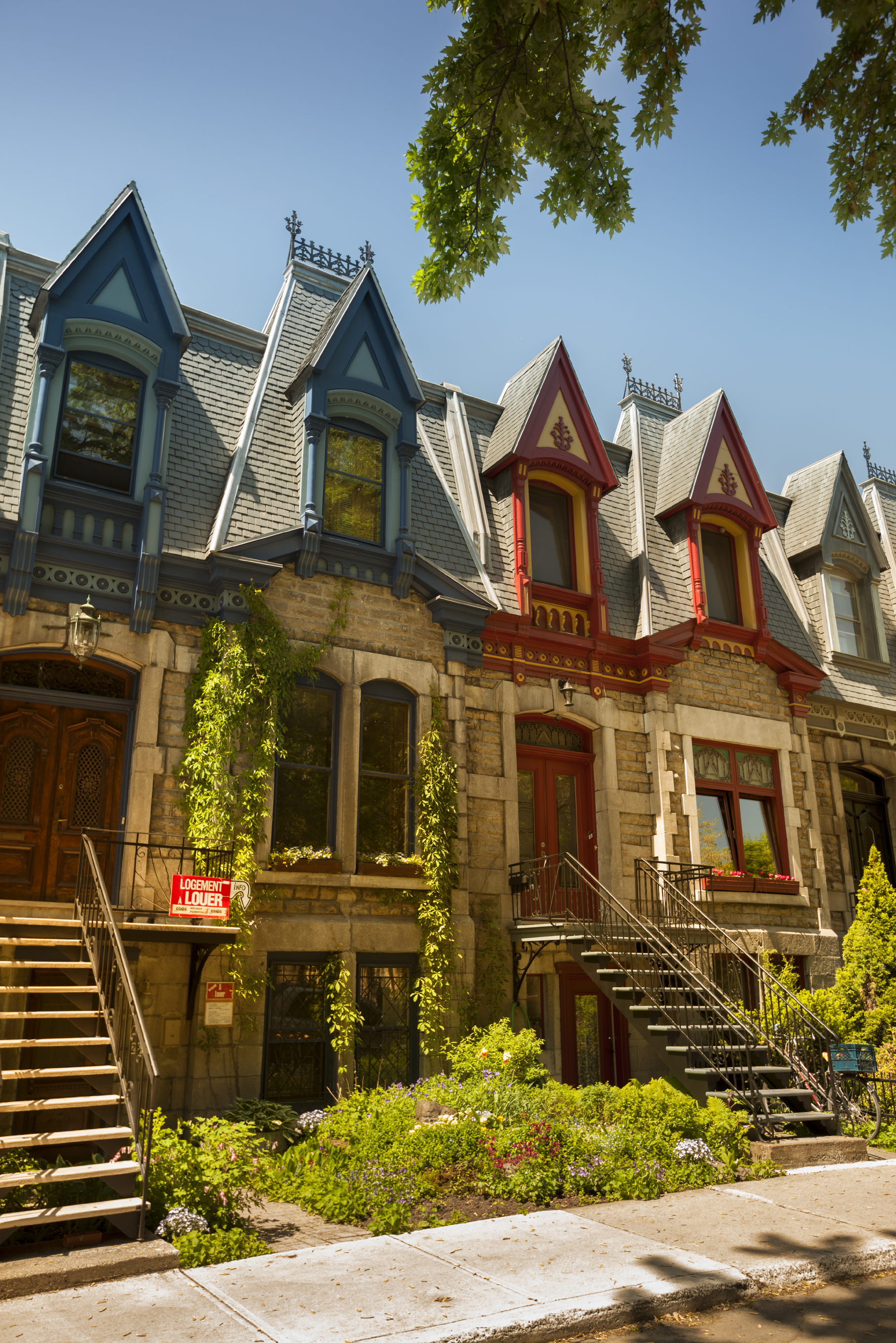
Montreal is the site of one of the world’s most unusual apartment developments. This development, called Habitat 67, stands on Cité du Havre, a strip of land that extends into the St. Lawrence River. Designed by the Canadian architect Moshe Safdie, Habitat 67 consists of about 150 apartments that look like a stack of concrete boxes. One apartment’s roof serves as the terrace of another.
Montreal’s city government strives to ensure decent housing, even in the poorest neighborhoods. The city has long had generous programs to help landlords make repairs and improvements. The city also spends a significant amount on “social housing,” a local term describing tax-supported rent for the poor.
Education.
Montreal’s public school system is organized on the basis of language. Three school boards administer French-language schools, and two school boards administer English-language schools. Montreal also has numerous religious and nonreligious private schools.
Montreal is the home of two internationally known research universities, the Université de Montréal (University of Montreal) and McGill University. Courses at the Université de Montréal are taught in French, and courses at McGill are conducted in English. Montreal’s other institutions of higher learning include Concordia University, an English-language university; and the Université du Québec à Montréal (University of Quebec at Montreal), which teaches classes in French. Specialized business and engineering schools also operate in Montreal. In addition, there are many junior colleges that serve as a step between secondary school and university.
Social problems.
Montreal faces many familiar urban problems. One of these problems is poverty. Montreal ended the 1900’s with a rapidly growing economy, and the city has a well-educated work force. But Montreal also attracts thousands of jobseekers from rural Quebec, some of whom lack skills or training. As a result, many people live in Montreal with little income other than public assistance.
Beginning in the early 1970’s, higher-income people, particularly francophones, began moving away from Montreal Island into off-island suburbs. As a result, lower-income people and immigrants became a higher proportion of Montreal’s population.
In 1974, the Quebec government made French the official language of the province. In 1976, the Parti Québécois (PQ), which favors Quebec’s independence from Canada, first gained control of the provincial legislature. The PQ has been in and out of power since then. These political developments have created tension between francophones and anglophones in Montreal and the rest of Quebec. Many English-speaking people, and some important companies that conduct business in English, have left Montreal and Quebec rather than switch to French.
Cultural life
Montreal is one of North America’s leading cultural centers. It has outstanding dance, drama, and musical groups, and its art galleries and museums rank among the finest in Canada. The city is also known for its many beautiful churches and well-planned parks. Montreal’s sports attractions include professional football and hockey.
Each year, millions of tourists visit Montreal. Many restaurants in Montreal specialize in French cooking. Visitors can also find restaurants featuring a wide variety of other ethnic foods.
The arts.
The world-famous Orchestre Symphonique de Montréal (Montreal Symphony Orchestra) and the Orchestre Métropolitain (Metropolitan Orchestra) make their home in the city. Other musical organizations in Montreal include L’Orchestre de Chambre I Musici de Montréal and Musica Camerata Montréal. The Centaur Theatre Company features English-language productions.

Summer is “festival season” in Montreal. Cultural events, performances, and shows run almost nonstop from June through August, drawing thousands of people downtown. The major festivals include the Festival International de Jazz de Montréal, the Festival des Films du Monde (World Film Festival), and the Just for Laughs/Juste pour Rire comedy festival.
Place des Arts at Rue Ste.-Catherine and Rue St.-Urbain is one of North America’s finest centers for the performing arts. The center includes the Salle Wilfrid-Pelletier concert hall, which can seat 3,000 people. The center also houses the smaller Maisonneuve and Jean-Duceppe theaters, both of which offer stage productions.
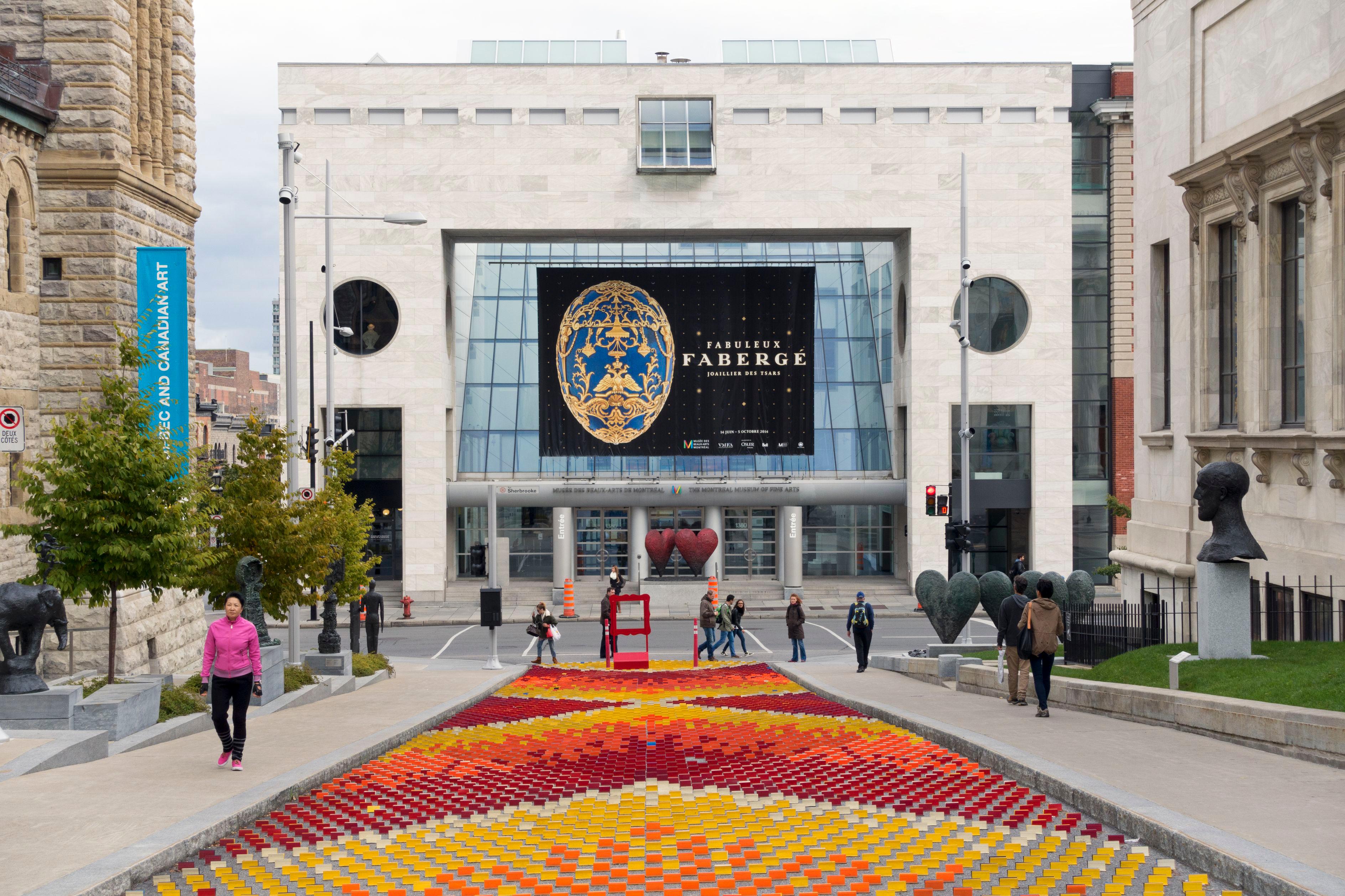
Libraries.
Montreal’s municipal library system has branches throughout the city. Its most important books and other resources are in French. However, English-language collections and items in other languages are also available. Other libraries in Montreal include the Bibliothèque et Archives nationales du Québec (National Library and Archives of Quebec), a major provincial library that is open to the public; the Jewish Public Library; and a number of university libraries.
Museums.
The downtown Musée des Beaux-Arts de Montréal (Montreal Museum of Fine Arts) is the city’s principal museum. It hosts major traveling exhibitions and also has a permanent collection of tens of thousands of objects. These items include major European works, Inuit art, other Canadian works, Asian and South American pieces, and collections of furniture, glass, lace, and silver. Founded in 1860, it is one of Canada’s oldest museums.
The Centre Canadien d’Architecture (Canadian Centre for Architecture) includes a museum, library, and conference center focusing on architecture past and present. The city also has the Musée d’Art Contemporain de Montréal (Montreal Museum of Contemporary Art) and a planetarium.
The Château Ramezay, in Old Montreal, dates from 1705. It was once the home of Claude de Ramezay, the second French governor of Montreal. The building has been a history museum since 1895. Other important history museums are the McCord Museum of Canadian History and the Pointe-à-Callière, Montréal Museum of Archaeology and History, which is built over an archaeological excavation of the original Ville-Marie.
Churches.
Montreal is famous for its hundreds of churches. Several are noted for their Gothic style architecture. St. Patrick’s Basilica, in downtown Montreal, serves English-speaking Roman Catholics. Basilique Notre-Dame (Notre Dame Basilica), in Old Montreal, is attended by French-speaking Catholics. This church has two towers, one of which houses a huge bell. This bell, called Le Gros Bourdon (the Great Bell), weighs 12 tons (11 metric tons). Notre Dame Basilica is also noted for its magnificently carved wooden interior.
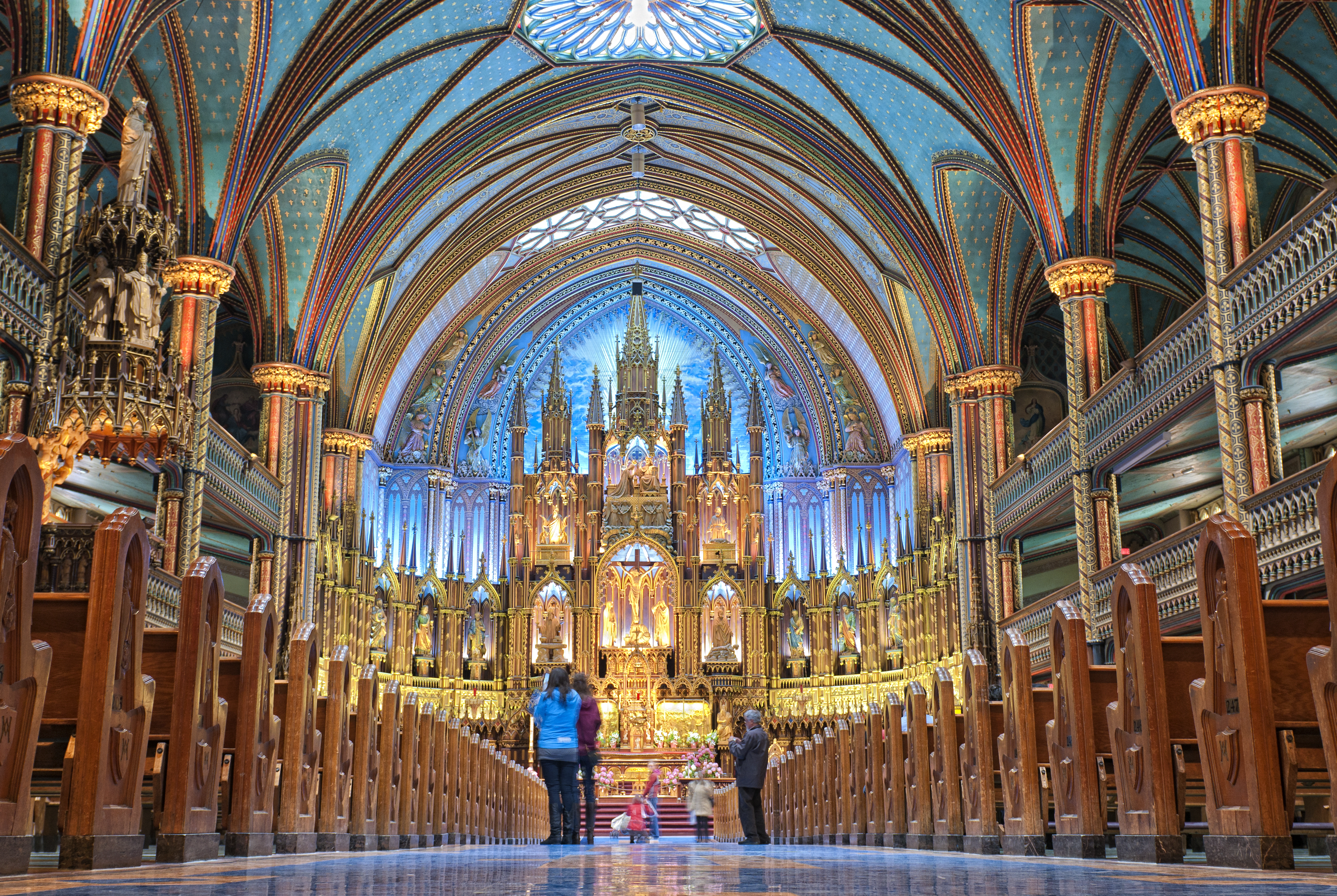
Notre-Dame-de-Bon-Secours is a well-known chapel in Old Montreal. Some Montrealers call it the Sailors’ Church. A statue of the Virgin Mary on the roof was once believed to perform miracles to help sailors.
The Basilique-Cathédrale Marie-Reine-du-Monde (Cathedral-Basilica of Mary, Queen of the World) stands in the heart of downtown Montreal. The designers of this church patterned it after St. Peter’s Basilica in Vatican City. The church serves as the seat of the Catholic archdiocese of Montreal. The seat of the Anglican diocese, Christ Church Cathedral, is also downtown. St. Joseph’s Oratory stands on the west slope of Mount Royal. Every year, hundreds of thousands of people visit this Roman Catholic shrine. Its founder, Brother André, has been credited with miraculous cures and was canonized (made a saint). The dome of the shrine is a major landmark. 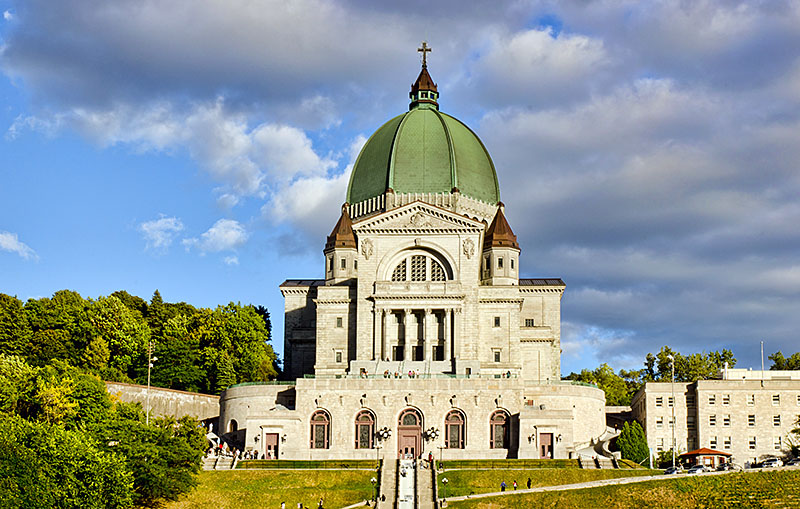
Parks.
Montreal has hundreds of parks and recreation areas. Mount Royal Park covers part of the top and eastern slope of Mount Royal, the hill-covered peak in the center of the city. The park was designed by Frederick Law Olmsted, who designed New York City’s Central Park. Mount Royal Park includes Beaver Lake, a popular spot for ice skating during the winter. Mount Royal also has lookout spots that offer visitors magnificent views of the Montreal area. A metal cross rises about 100 feet (30 meters) on the mountain’s east side. The cross, illuminated at night, is a memorial to Ville-Marie’s survival of a flood in 1642.
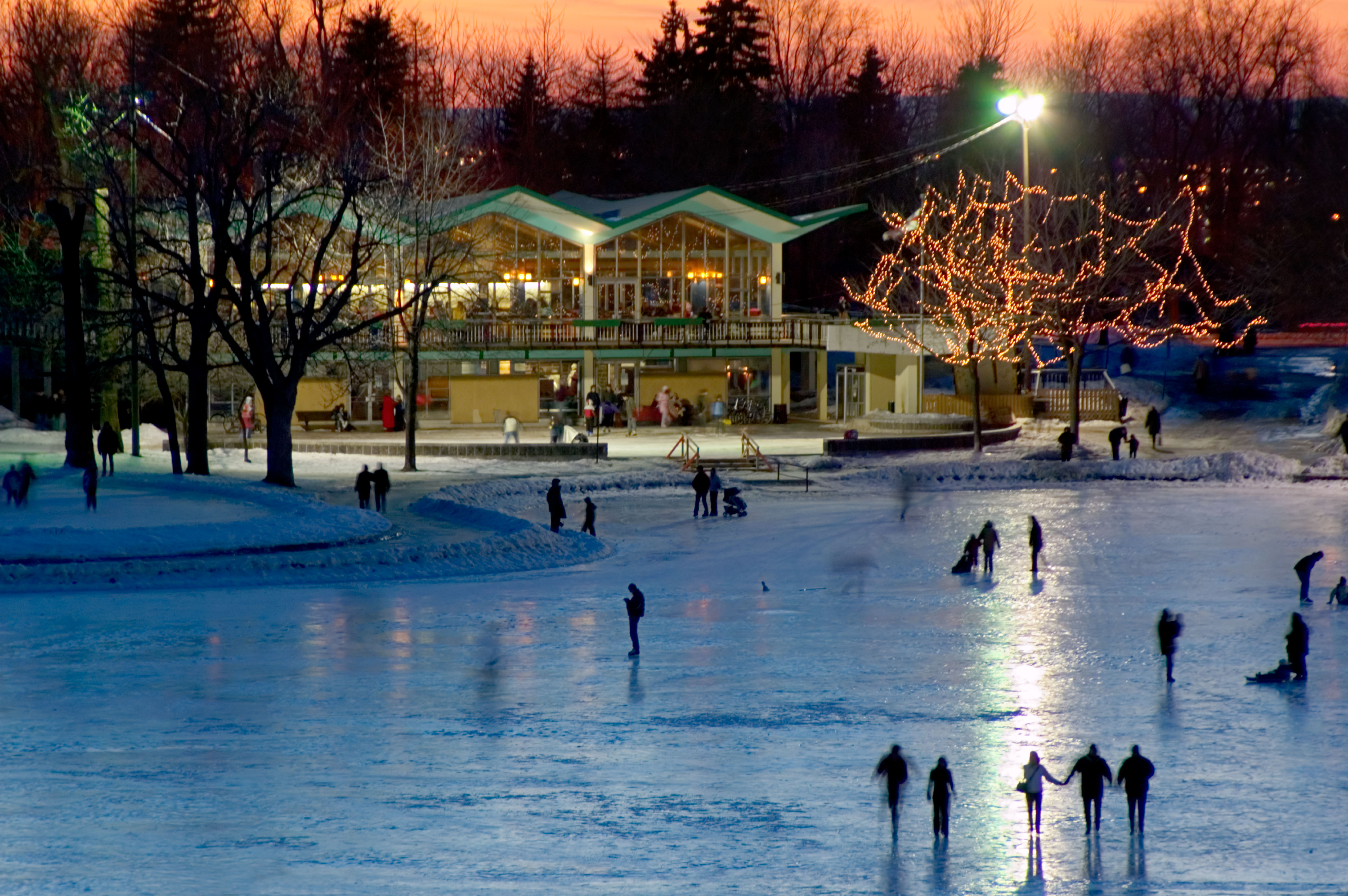
A world-class Jardin Botanique (botanical garden) lies in Montreal’s east end near the Olympic Stadium. This vast attraction features gardens with various themes, including the Chinese Garden, the Japanese Garden, and the Rose Garden. Also on the Botanical Garden grounds is the Montreal Insectarium, which displays thousands of live and mounted insects.
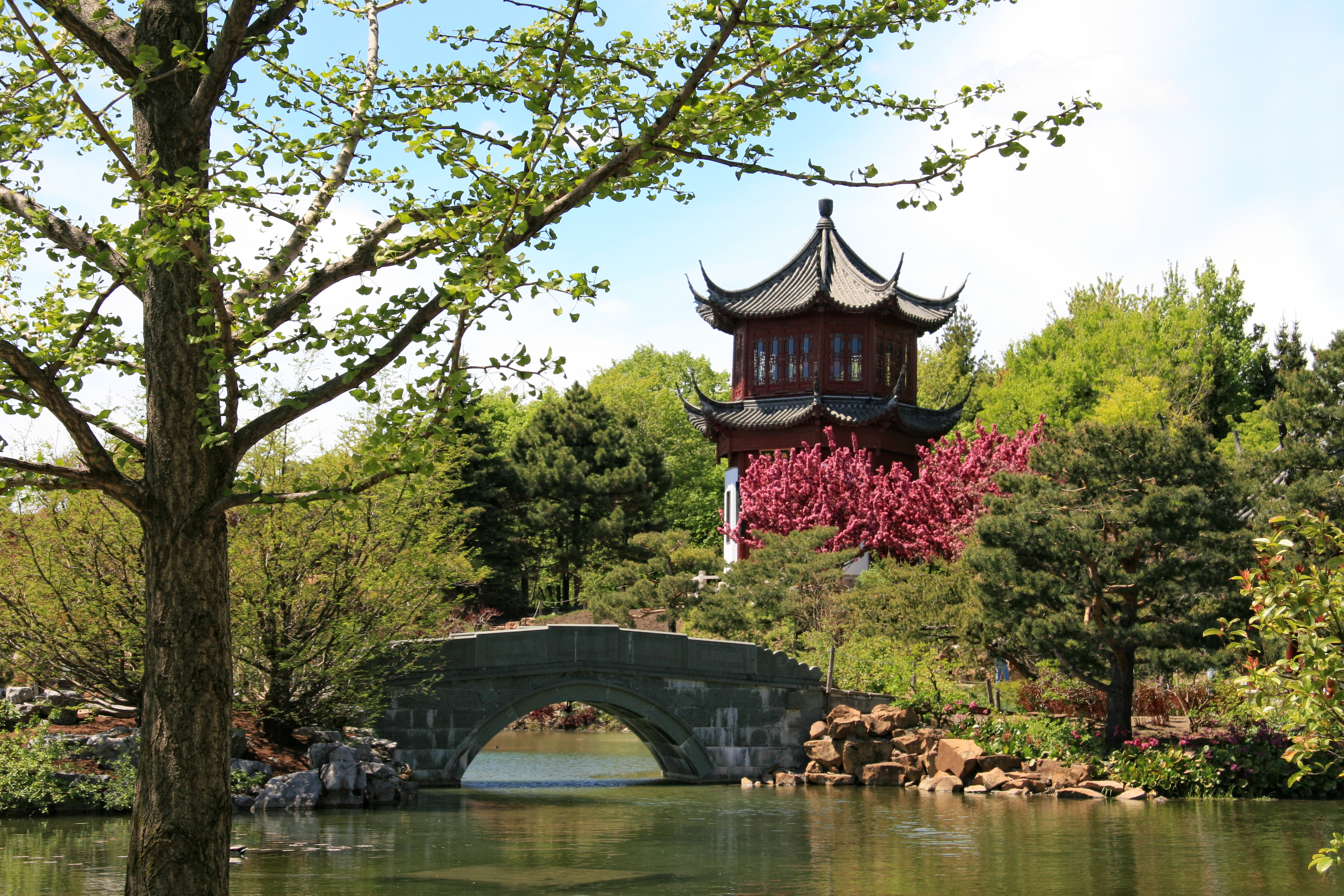
Another large park, Parc Jean-Drapeau (formerly Parc des Îles), covers Île Ste.-Hélène and Île Notre-Dame. Île Ste.-Hélène was expanded significantly and Île Notre-Dame was constructed artificially to provide the site of Expo 67, the world’s fair held in Montreal in 1967. Both islands lie in the St. Lawrence River south (geographically east) of Montreal Island. Parc Jean-Drapeau includes numerous green spaces, the Montreal casino, and La Ronde amusement park, open during the summer months.
Sports.
The Montreal Canadiens of the National Hockey League have won more Stanley Cup championships than any other team in professional hockey. Montreal is also the home of the Montreal Alouettes of the Canadian Football League and CF Montreal of Major League Soccer.
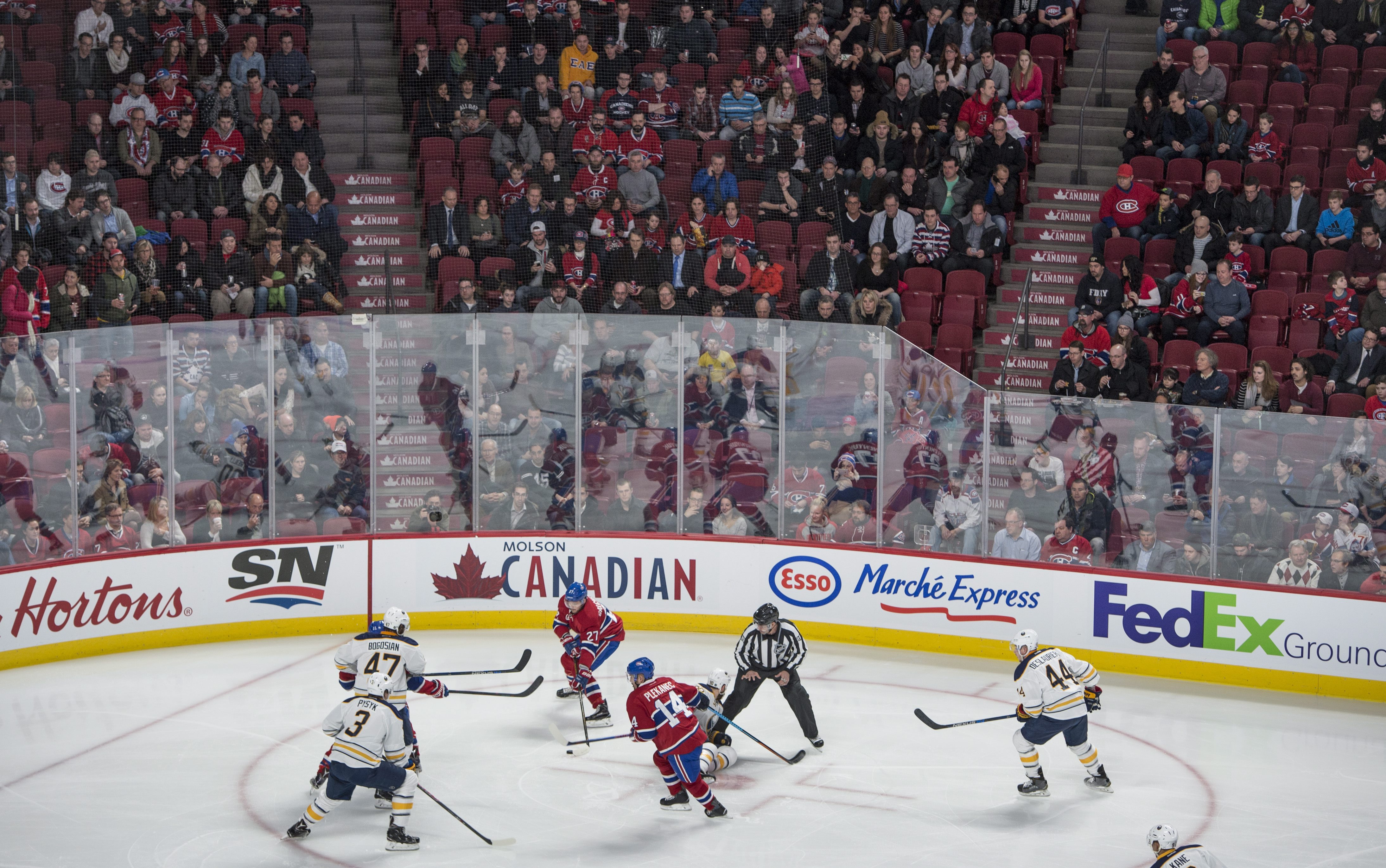
Winter sports are a major attraction in the Montreal area. Cross-country skiers and tobogganers rush to Mount Royal after a snowfall. Downhill skiing is popular in the nearby Laurentian Mountains and Eastern Townships.
Economy
Montreal is one of Canada’s chief transportation centers. It is also an important financial and industrial center. Only Toronto is more important. In addition, Montreal lies in the most fertile and productive agricultural region of Quebec. As a result, the city has become a food-processing center.
Montreal’s economy was once controlled by private companies that used English as the language of business. As a result, Montrealers needed a good knowledge of English to obtain a well-paying job. Since 1977, however, the Quebec government has required all companies that employ 50 or more people to use French as the language of business.
Transportation.
The St. Lawrence River links Montreal with the Atlantic Ocean, about 1,000 miles (1,600 kilometers) to the northeast. The Saint Lawrence Seaway extends shipping services 1,300 miles (2,090 kilometers) inland. It makes Montreal a major stopover point for ships sailing between the Great Lakes and the Atlantic).
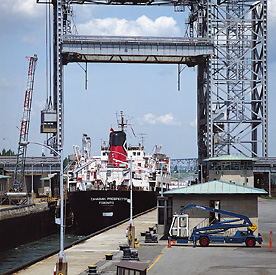
The Port of Montreal, also called Montreal Harbour, stretches 15 miles (24 kilometers) along the north (geographic west) bank of the St. Lawrence River. It serves oceangoing, coastal, and inland vessels and handles millions of tons of cargo yearly.
Montreal ranks as one of Canada’s largest railroad centers. Canadian National Railway, a transcontinental rail line, has its headquarters in the city. This railroad carries freight east to the Atlantic seaboard and west to the Pacific coast. Several railways connect Montreal and cities in the United States.
Major airlines use Montreal-Pierre Elliott Trudeau International Airport, which lies in the western part of Montreal Island. Montreal-Mirabel International Airport, northwest of the island, handles mainly air freight. Air Canada, the nation’s largest commercial airline, has its headquarters in the city. The International Civil Aviation Organization, a specialized agency of the United Nations, also has its headquarters there.
Several major highways serve Montreal. The Trans-Canada Highway, which runs from coast to coast, crosses Montreal Island. Nearly 20 railroad and highway bridges connect the island with Laval and the south (geographic east) shore of the St. Lawrence River.
A subway system called the Métro, buses, and commuter trains provide public transportation on Montreal Island. The Métro, which opened in 1966, was the first subway in the Western Hemisphere to use cars with rubber tires. Brightly colored mosaics and architectural designs decorate many Métro walls. Because of these decorations, the Métro has been called “the largest underground art gallery in the world.” 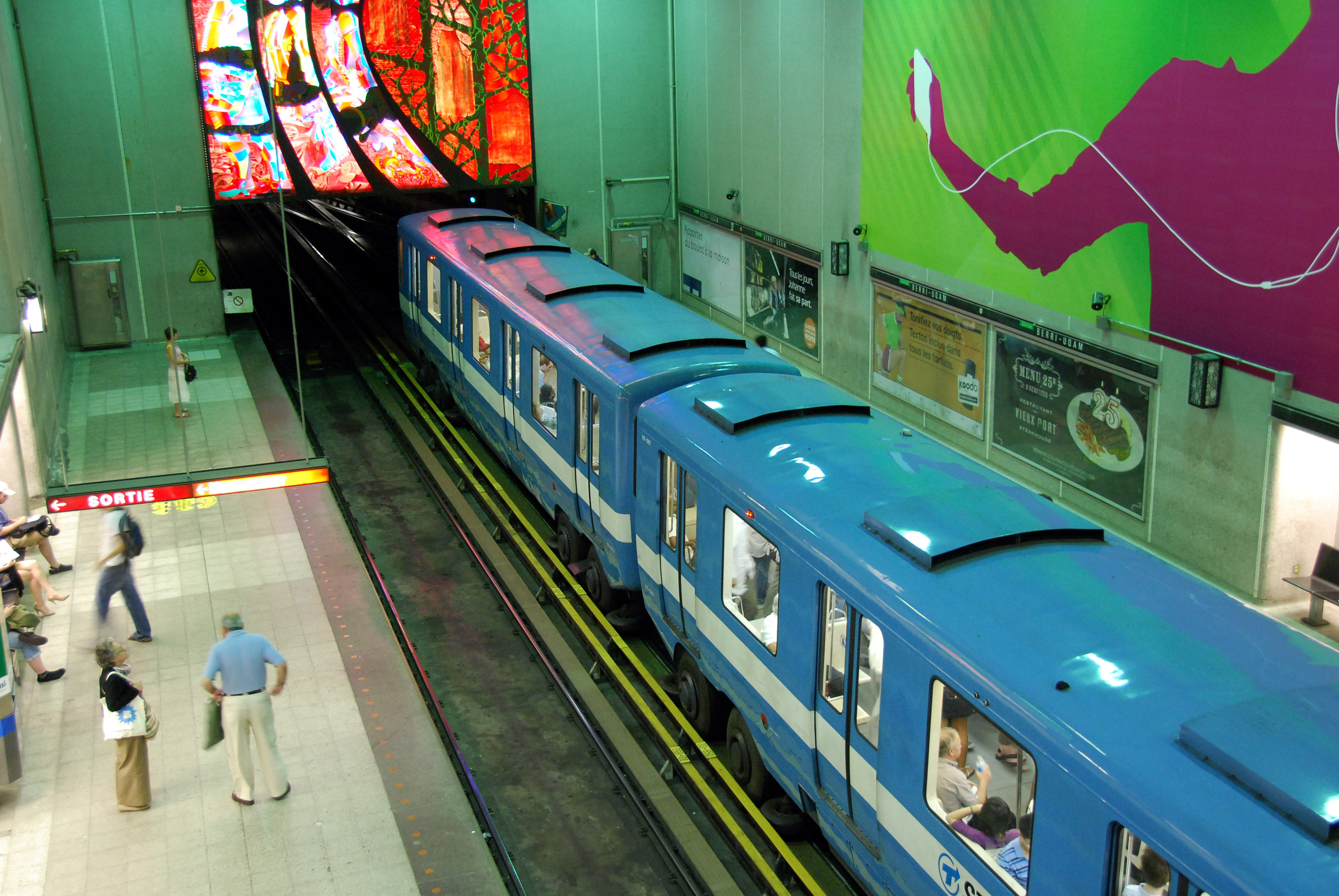
Industry.
Manufacturing is an important source of employment in Greater Montreal. Thousands of factories in the area employ more than 10 percent of its workforce. These plants account for much of Quebec’s industrial production.
Greater Montreal’s leading industries include the manufacture of aircraft and parts, the manufacture of telecommunications equipment, and food processing. The area’s chief food products are beer, canned goods, and sugar.
Greater Montreal is also one of Canada’s major centers for the manufacture of chemicals, clothing, and tobacco products. Pharmaceuticals are an important chemical product. Petroleum refineries in Montreal produce much of Canada’s gasoline. Montreal’s historic fur industry still thrives, as do newer firms that produce computer software and other high-technology products.
Trade and finance.
Companies in Greater Montreal play an important role in Canada’s international trade. Montreal’s bilingual culture gives it special access to French and other European trade.
Companies engaging in wholesale and retail trade within Canada employ many people in Greater Montreal. Wholesale companies sell goods to retail stores, and retail companies sell goods to consumers. Area retail stores include some of Canada’s largest department stores. Place Bonaventure, in downtown Montreal, is one of the largest commercial buildings in the world. It has more than 3 million square feet (280,000 square meters) of space.
Montreal has branches of all of Canada’s major banks. Two of these banks, the Banque Nationale du Canada (National Bank of Canada) and Laurentian Bank, have their headquarters in Montreal. Banks, credit organizations, savings firms, and other financial companies in the area employ many people. Loans by these companies contribute to the growth of business and industry throughout Canada. The Bank of Montreal, founded in 1817, was the first bank in Canada.
The Bourse de Montréal (Montreal Exchange), Canada’s first stock market, opened in the city in 1874. In 2008, the Bourse de Montréal merged with the TSX Group, which includes the Toronto Stock Exchange, to form the TMX Group.
Communication.
Three daily newspapers are published in Montreal. Two of the papers—Le Devoir, and Le Journal de Montréal—are written in French. The Montreal Gazette is the only Montreal daily in English. Le Journal de Montréal has the largest circulation of any of Quebec’s daily papers. The Gazette, founded in 1778, was the first newspaper published in Montreal.
Several radio and television stations broadcast from the city, about half of them in French and the other half in English. Station CFCF of Montreal was Canada’s first radio station. It began broadcasting in 1919. Radio-Canada, the French-language network of the Canadian Broadcasting Corporation (CBC), is based in Montreal. More French-language TV programs are produced in Montreal than in any other city in the world except Paris. Television station CBFT, one of the first two Canadian stations, began broadcasting from Montreal in 1952. The other pioneer station was CBLT of Toronto.
Government
The city of Montreal has a mayor-council form of government. Voters elect the mayor and the 64 other City Council members to four-year terms. The mayor acts as the administrative head of the city government. He or she supervises the various city departments. The City Council passes the city’s ordinances. It also appoints and dismisses directors of city departments and adopts the annual city budget.
The city is divided into 19 boroughs, each with its own borough council. These councils are responsible for local affairs. The 19 borough mayors are also City Council members. The Agglomeration Council, made up of elected representatives from all the municipalities on the Island of Montreal, handles such matters as security, municipal courts, homeless aid, waste management, and public transit.
A significant portion of the city of Montreal’s revenue comes from taxes on property. The rest of the city’s funds come from taxes on businesses, water, and amusements, and from aid given by the province.
Like most other big cities, Montreal has difficulty finding ways to pay for the rapidly rising costs of government services. The major problems faced by Montreal’s government include building more low-cost housing and maintaining the city’s infrastructure (public services and facilities).
History
Algonquian- and Iroquoian-speaking First Nations people lived and traded in the Montreal region before European settlers arrived. The area’s rivers and lakes provided these people with a plentiful supply of fish. The waterways also served as excellent transportation routes.
Exploration.
In 1535, the French explorer Jacques Cartier sailed up the St. Lawrence River. He then explored the Island of Montreal and visited the First Nations village of Hochelaga near the foot of Mount Royal. Several thousand people lived in the village. Cartier climbed Mount Royal, from which he could see that the Lachine Rapids would prevent him from following the river farther inland by boat. Another famous French explorer, Samuel de Champlain, visited the site of Montreal in 1603 and 1611. By that time, Hochelaga and its inhabitants had disappeared. Historians do not know the reason for the disappearance of Hochelaga and its inhabitants.
French settlement.
In 1639, Jéréme Le Royer, Sieur de la Dauversière, a French tax collector, formed a company in Paris to establish a colony on the Island of Montreal. In 1641, the company sent a Roman Catholic missionary group to the island to convert the First Nations people to Christianity. The group, led by Paul de Chomedey, Sieur de Maisonneuve, arrived in 1642. The colonists built a fort at what is now Place Royale in Old Montreal and established the settlement of Ville-Marie.
Iroquois Indians attacked the colony, hoping to stop the profitable fur trade that the French had established with the Algonquin and Huron. The Algonquin and Huron were the chief rivals of the Iroquois. In 1660, Adam Dollard des Ormeaux led an expedition of young men from Ville-Marie to protect the colony from Iroquois attack. The men were killed by the Iroquois. Some historians think the colonists’ true motive was to ambush the Iroquois and steal from them. Ville-Marie remained under constant threat of attack until a French regiment arrived in 1665. In 1667, the regiment secured a temporary peace. However, the French and Iroquois did not establish a lasting peace agreement until 1701.
By the early 1700’s, Ville-Marie had become known as Montreal. It had a population of about 3,000 in 1705 and was becoming the commercial heart of France’s North American empire, called New France. Montreal’s location on the St. Lawrence River made it an important center of trade. European goods passed through Montreal on the way to the North American west. Fur traders shipped pelts from Canada’s interior to Europe by way of Montreal.
British settlement.
British troops under General Jeffrey Amherst captured Montreal in 1760, during the French and Indian War (1754-1763). The surrender of Montreal marked the end of the fighting in this war and signalled the defeat of New France. The Treaty of Paris, signed in 1763, officially ended the French and Indian War and made Canada a British colony. A few English-speaking settlers then came to Montreal.
General Richard Montgomery’s American forces occupied Montreal in November 1775, during the American Revolution (1775-1783). Benjamin Franklin and other American diplomats tried to gain French-Canadian support against the British. But their efforts failed, partly because most French Canadians regarded the war as just a quarrel between Britain and its colonies. In June 1776, the arrival of British troops forced the American soldiers to withdraw, and Montreal became a British possession again.
Fur traders in Montreal founded the North West Company as a rival to the Hudson’s Bay Company fur trade. The new firm was first organized in the 1770’s.
Montreal began to expand on the Island of Montreal in the late 1700’s. English-speaking merchants began to establish businesses in Montreal during this period. They gradually gained control of the town’s economy, in part because many French merchants had returned to France after British troops captured the city in 1760.
The early 1800’s.
By 1800, Montreal’s population had reached 9,000. Canada’s first steamboat, the Accommodation, sailed the St. Lawrence River from Montreal to the city of Quebec in 1809. In 1821, the Hudson’s Bay Company bought the North West Company. Montreal declined as a fur-trading center.
The Lachine Canal, which crosses the southern edge of Montreal, opened in 1825. It provided a detour for small vessels around the river’s Lachine Rapids and led to a sharp increase in trade and travel between Montreal and the Great Lakes. Parts of the canal called locks also became an important source of water power for manufacturing. Shipping replaced fur trading as Montreal’s chief industry, and Montreal grew in importance as a port.
In 1832, Montreal was incorporated as a city. From 1844 until 1849, it served as the capital of the Province of Canada. By 1850, the city’s population had soared to about 50,000. For a short period, the majority of Montreal’s population was English-speaking.
The growing city.
Montreal continued to develop as a transportation center during the mid-1800’s, when railways linked it to Portland, Maine, and to areas west of Toronto. Investment by wealthy English-speaking merchants helped Montreal become a major industrial center during this period. Many industries were built along the Lachine Canal. Thousands of British immigrants, and French Canadians from other parts of Quebec, came to Montreal to find jobs in the new factories. By 1871, about 107,000 people lived in Montreal. About half of these people were of French ancestry.
The Canadian Pacific Railway Company, based in Montreal, completed Canada’s first transcontinental railroad in 1885. The railroad attracted more industry and brought new prosperity to the city. By 1901, Montreal’s population had risen to about 268,000. The annexation (addition) of several neighboring communities helped it reach about 468,000 by 1911.
The war issue.
During World War I (1914-1918), Canada fought on the side of the Allies, which included France, the United Kingdom, and the United States. Some French Canadians in Montreal supported the government’s policy and volunteered for the war, as did many of the city’s English-speaking citizens. But many French Canadians, feeling little loyalty to the United Kingdom, took almost no interest in the war. In 1917, Canada’s government introduced a military draft, also known as conscription. Many French Canadians opposed this policy, and riots occurred in Montreal.
During World War II (1939-1945), conscription again caused unrest among French Canadians. In 1940, Montreal Mayor Camillien Houde was jailed for urging Montrealers to defy a Canadian government plan to register the country’s men for possible military service. Tensions increased after the Canadian government introduced a draft for overseas service in 1944. However, they did not cause a crisis as large as that seen during World War I.
The changing city.
By the early 1950’s, Montreal’s population had topped 1 million. During the late 1950’s, the city entered a period of great economic growth. In 1958, a city development program enlarged Montreal Harbour. The opening of the St. Lawrence Seaway in 1959 attracted hundreds of industries.
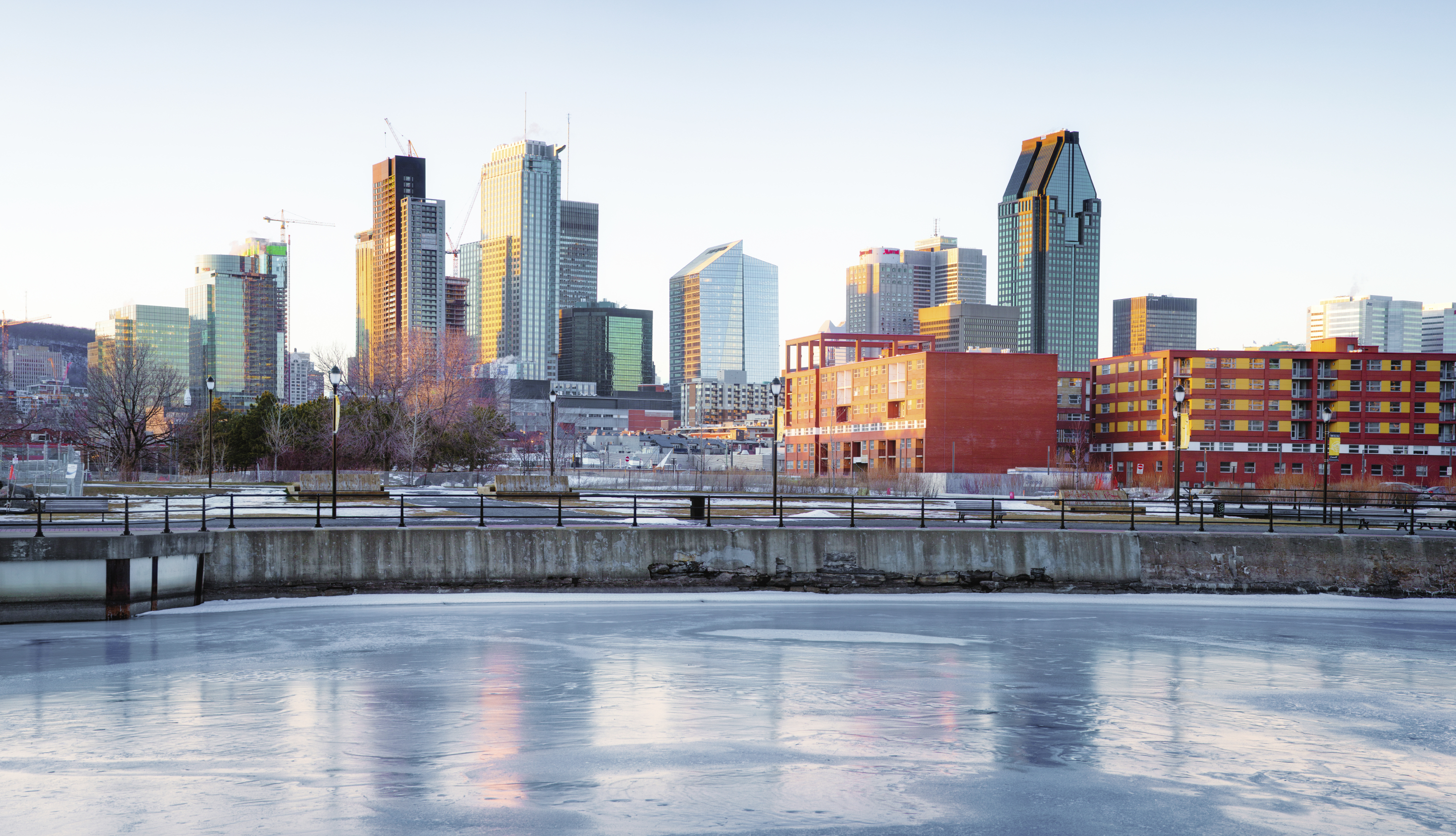
During the 1960’s, a construction boom in downtown Montreal gave the city a new skyline. Private developers tore down old structures throughout the area and replaced them with wider, car-friendly streets, hotels, and modern office buildings. Important downtown developments during this period included the Place Ville Marie and Place Victoria skyscrapers; Place Bonaventure, a trade mart; and Place des Arts, a cultural center. An underground shopping network was also constructed. However, the 1960’s also saw the first efforts to preserve the architecture of Old Montreal.
The city built new highways and a new subway, the Métro, to help serve visitors attending Expo 67, a world’s fair held in Montreal in 1967. More than 50 million people attended the exhibition.
In 1975, the Montreal-Mirabel International Airport opened. Montreal hosted the 1976 Summer Olympic Games. Construction for the event included housing for the athletes and a new sports stadium. Montreal officials began to rent the housing to the public in 1978. Jean Drapeau, the city’s longest-serving mayor, held office from 1954 to 1957 and again from 1960 until 1986.
The separatist movement.
In the 1960’s, a number of political parties began to advocate the separation of Quebec from the rest of Canada to create an independent nation. Other groups, such as the Front de Libération du Québec (Quebec Liberation Front, or FLQ), turned to violence to promote separatism. Such violence included several bombings and armed robberies, chiefly in the Montreal area.
In October 1970, members of the FLQ kidnapped British Trade Commissioner James R. Cross and Quebec Labor Minister Pierre Laporte. This crisis led Canadian Prime Minister Pierre Trudeau, a French Canadian born in Montreal, to send federal troops to Montreal and other Quebec cities to guard government officials. Laporte was murdered by his captors and Cross later was released. Police eventually arrested the four FLQ members responsible for Laporte’s murder, and all but one of Cross’s kidnappers fled to Cuba.
By the mid-1970’s, most separatists had rallied to the Parti Québécois (PQ). The PQ, led by René Lévesque, won the 1976 Quebec general election and formed a government. In 1977, the PQ government passed a law that required all companies with 50 or more employees to use French as the language of business. It also required that all signs be printed only in French. As a result, several major corporations based in Montreal that had primarily used English in the course of business left the city.
The late 1900’s and early 2000’s.
In 1982, Montreal annexed the northern suburb of Pointe-aux-Trembles. This annexation increased the area of Montreal by about 10 percent. Development of downtown Montreal continued in the 1980’s and 1990’s. The Old Port area was developed for recreation and tourism during this period.
In the 1980’s and 1990’s, the focus of Montreal’s economy changed greatly. Old manufacturing plants closed, and new high-technology companies moved into the city. Montreal’s unemployment rate, which has often been high, dropped in the late 1990’s as high-technology firms competed for skilled workers.
In 2000, the Quebec legislature passed Bill 170, a law to merge the 28 municipalities on Montreal Island and some adjacent islands. This law, which took effect at the beginning of 2002, provided for one city of Montreal stretching over the entire area. In 2004, voters in 15 communities elected to demerge from Montreal. These communities became separate municipalities as of Jan. 1, 2006.
